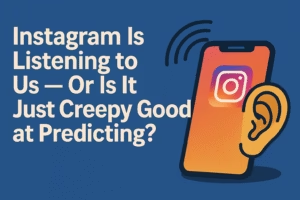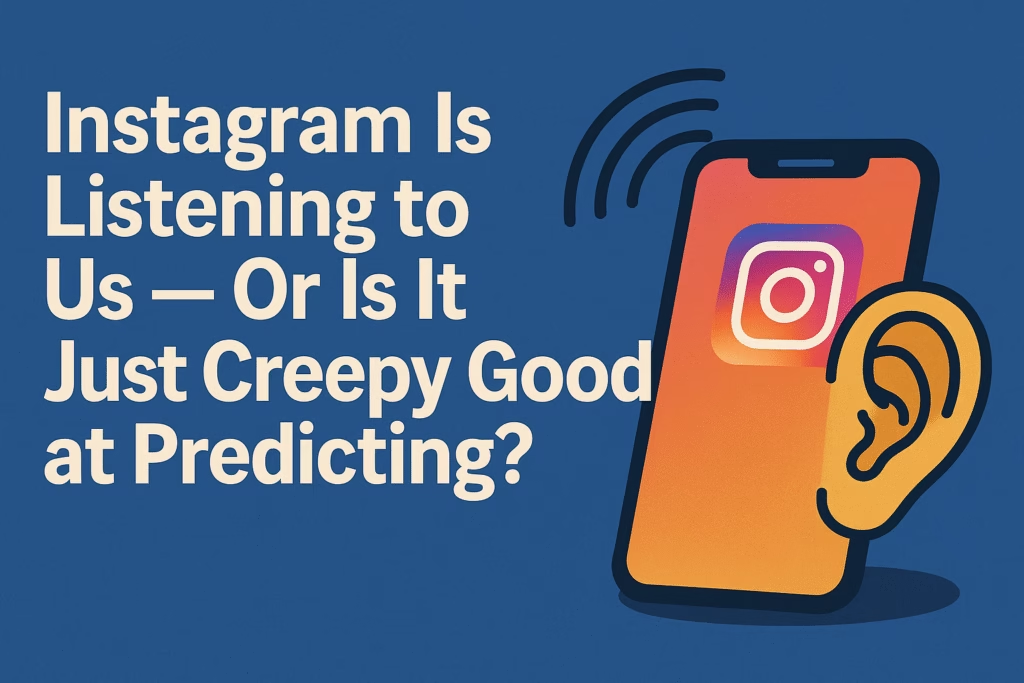If you’ve ever casually mentioned a random topic—say, a movie, a food craving, or a vacation idea—and then seen a post about it appear on Instagram minutes later, you’re in good (if slightly creeped out) company.

One recent Reddit thread reignited this paranoia when a user reported watching Titanic on a disconnected, non-smart TV in their kitchen—only to have a Titanic-themed Instagram Reel waiting for them the moment they opened the app.
This kind of experience feels less like coincidence and more like surveillance. But is it really about eavesdropping—or are the algorithms just terrifyingly accurate?
What Actually Happened?
The Redditor was clear: no searches, no connected devices, no digital trace related to Titanic. Just a private viewing of a decades-old film—and then an instant flood of algorithmically chosen content related to it.
That’s what made the post blow up. The possibility that Instagram might be listening, even without a visible trigger, struck a nerve. But the more probable (and scarier) explanation? It didn’t have to.
The Predictive Algorithm Theory
Several commenters, including ex-employees in tech, broke it down: Instagram doesn’t need to eavesdrop. It already has enough data to predict what you’ll find relevant—even before you know it’s relevant.
Here’s how:
- TV programming signals: Advertising systems are often synced with broadcast schedules
- Ambient device signals: Your phone is aware of nearby Bluetooth or Wi-Fi signals, even from dumb devices
- Cross-device behavior: If anyone in your home searched for Titanic on their phone, Meta may link that to you
- Geo-context and behavior profiling: Your location, time of day, and even past app activity can all point to certain interests
In short: it’s less about your words and more about your context. Which makes it creepier, not safer.
The Phone Microphone Myth

A popular theory persists: your mic is always on. After all, your phone can respond to “Hey Siri” or “OK Google” without you touching it, right?
That’s technically true—but with caveats. Voice activation is processed locally on your device, not sent to Meta’s servers. And when apps use your microphone, iOS and Android systems now display a colored icon or indicator. If Instagram were passively recording ambient audio 24/7, regulators (and Apple) would come down hard.
So while paranoia is understandable, passive listening by Instagram—especially without user consent—is unlikely.
The Truth Is Worse
What’s actually happening is far more unsettling: Instagram builds a detailed behavioral model based on everything else you do. It’s surveillance without the spy mic.
Instagram (and Meta) are collecting:
- Media consumption: YouTube, Netflix, podcasts
- Proximity data: who you’re physically near, via Bluetooth
- Device interactions: which apps you opened, which ones are running
- Sensor signals: ambient light, motion, time of day
- Third-party app behavior: browsing history, search logs, purchases
- Cross-device linkage: your laptop activity, smart TVs, and even shared cloud logins
This is how they predict your interest in Titanic without you ever saying the word. It’s not a guess. It’s data-driven deduction.
One Redditor nailed it:
“It’s not about the mic. It’s about how much data we willingly hand over—and how good they’ve gotten at connecting the dots.”
Can You Actually Stop It?

You can’t stop the algorithm from analyzing. But you can slow it down.
1. Cut Data at the Source
- Turn off mic access for Instagram
- Limit location tracking to “While Using the App”
- Disable camera permissions when not filming
2. Use Alternative Tools
- Consider a browser that blocks trackers. Brave or DuckDuckGo offer better privacy defaults.
- Use VPNs or alternative DNS settings to obscure your traffic source.
3. Rethink Your Sharing Habits
The less you interact with Instagram Reels, Stories, or Explore content, the harder it becomes for Instagram to feed its feedback loop. Every view, like, or pause trains the algorithm—even if you don’t realize it.
4. Test and Observe
If you’re really curious, try this:
- Talk about a very specific topic near your phone
- Ensure you’ve never searched for it
- See what appears on Instagram in the next 48 hours
If you notice a correlation, take screenshots, note timestamps, and document everything. While it won’t prove surveillance, it might just help fuel a broader conversation.
Why It Feels So Personal
Algorithms aren’t random. They’re statistical prediction machines trained on trillions of inputs. You’re just a small node in a vast network. But the moment Instagram serves a post that aligns perfectly with your real-life moment, the illusion breaks—and the tech feels alive.
Combine that with facial recognition, geo data, smart home devices, and shared app ecosystems, and you get a machine that knows you better than most friends.
That’s not a glitch. That’s the goal.
What Meta Says (and Doesn’t)
Meta has denied using your phone’s mic without explicit permission. They’ve issued multiple statements over the years reiterating that ads are not served based on mic audio.
But they’ve also built one of the most powerful data pipelines in existence—spanning WhatsApp, Facebook, Instagram, Oculus, Messenger, and beyond. They don’t need your mic.
And while you may not remember giving permission, chances are you already did—buried in those long-forgotten settings or consent screens.
Don’t Just Blame the App
It’s tempting to point fingers at Instagram. But the truth is, the entire smartphone ecosystem enables this level of access. It’s an agreement between OS, apps, networks, and your own behavior.
Yes, it’s invasive. But it’s also the cost of “free” platforms.
It’s Not Just You
Still doubting? Scroll through Reddit, Twitter, or even YouTube comments, and you’ll see story after story of people experiencing the same eerie moment. It’s not new, and it’s not rare. It’s just finally hitting a saturation point.
That’s why more people are seeking alternatives. Tools like The Social Proxy help creators and marketers stay anonymous while running their content operations—and avoid leaking behavioral signals.
Final Word
Instagram may not be listening to your every word. But it’s definitely watching—closely. The next time you feel paranoid, remember: you’re not crazy. You’re just living in a system that’s optimized to know you better than you know yourself.
If that’s not reason to rethink your data exposure, what is?



Pingback: Instagram Feed Not Loading? You’re Not Alone — Android Users Hit by New IG Bug - Social Tips Master